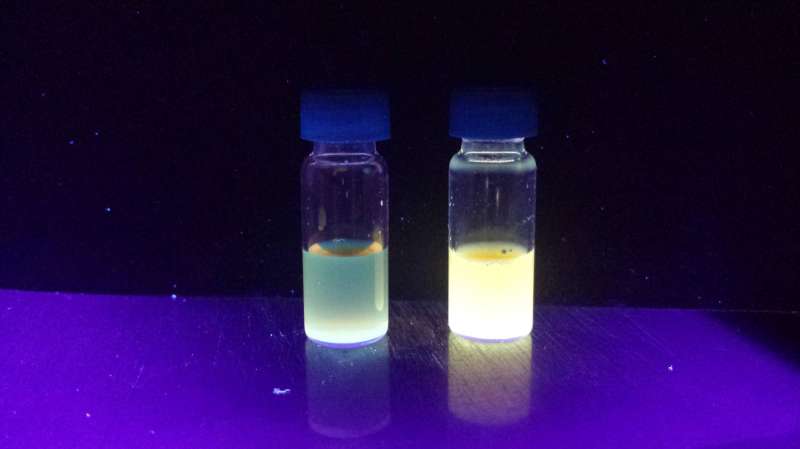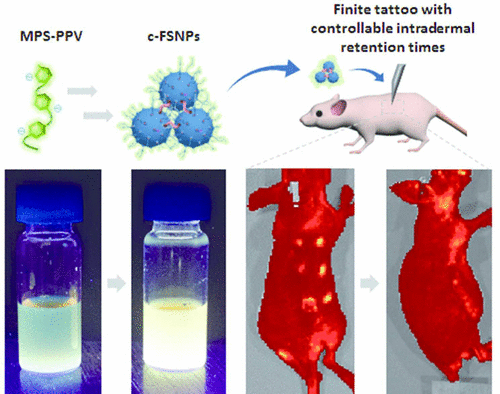Tattoos mark the spot—for surgery—then disappear

Tattoos aren't just for body art. They can have medical applications, too. Doctors are using them on patients to mark an area for future treatment—particularly for non-melanoma skin cancer such as basal cell carcinoma—but the inks can cause problems. Now scientists have developed a better solution. In the journal ACS Nano, they report a new ink that glows only under certain light conditions and can disappear altogether after a period of time.
Patients diagnosed with skin cancer typically have to wait up to three months between a biopsy confirming their condition and treatment. Doctors can mark the spot for possible future treatment using carbon graphite, India ink or fluorescent dye. But these pigments permanently color the skin, and can require laser or surgical removal after a patient has undergone surgery. They can also cause inflammation and discomfort at the site of the tattoo. Kai Chen, Gary S. Chuang, Hsian-Rong Tseng and colleagues wanted to develop a safer, more patient-friendly option.
The researchers created a time-limited pigment by cross-linking fluorescent supramolecular nanoparticles. Under ambient lighting, the nanoparticles are invisible, which would avoid unwanted markings in a patient's skin. But the pigment glows under light shining at a wavelength of 465 nanometers, so doctors would be able to use a special light to see the dye. Testing in mice showed that tattoos created with these nanoparticles didn't cause inflammation and lasted for three months. This would be long enough to mark a spot from biopsy through treatment for a non-melanoma patient.

More information: Jin-sil Choi et al. Cross-Linked Fluorescent Supramolecular Nanoparticles as Finite Tattoo Pigments with Controllable Intradermal Retention Times, ACS Nano (2016). DOI: 10.1021/acsnano.6b06200
Abstract
Tattooing has been utilized by the medical community for precisely demarcating anatomic landmarks. This practice is especially important for identifying biopsy sites of nonmelanoma skin cancer (NMSC) due to the long interval (i.e., up to 3 months) between the initial diagnostic biopsy and surgical treatment. Commercially available tattoo pigments possess several issues, which include causing poor cosmesis, being mistaken for a melanocytic lesion, requiring additional removal procedures when no longer desired, and potentially inducing inflammatory responses. The ideal tattoo pigment for labeling of skin biopsy sites for NMSC requires (i) invisibility under ambient light, (ii) fluorescence under a selective light source, (iii) a finite intradermal retention time (ca. 3 months), and (iv) biocompatibility. Herein, we introduce cross-linked fluorescent supramolecular nanoparticles (c-FSNPs) as a "finite tattoo" pigment, with optimized photophysical properties and intradermal retention time to achieve successful in vivo finite tattooing. Fluorescent supramolecular nanoparticles encapsulate a fluorescent conjugated polymer, poly[5-methoxy-2-(3-sulfopropoxy)-1,4-phenylenevinylene] (MPS-PPV), into a core via a supramolecular synthetic approach. FSNPs which possess fluorescent properties superior to those of the free MPS-PPV are obtained through a combinatorial screening process. Covalent cross-linking of FSNPs results in micrometer-sized c-FSNPs, which exhibit a size-dependent intradermal retention. The 1456 nm sized c-FSNPs display an ideal intradermal retention time (ca. 3 months) for NMSC lesion labeling, as observed in an in vivo tattoo study. In addition, the c-FSNPs induce undetectable inflammatory responses after tattooing. We believe that the c-FSNPs can serve as a "finite tattoo" pigment to label potential malignant NMSC lesions.
Journal information: ACS Nano
Provided by American Chemical Society



















